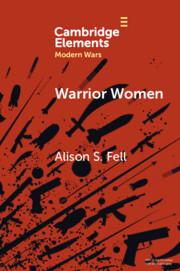Element contents
Warrior Women
Published online by Cambridge University Press: 08 May 2023
Summary
- Type
- Element
- Information
- Series: Elements in Modern WarsOnline ISBN: 9781009070089Publisher: Cambridge University PressPrint publication: 18 May 2023
Bibliography
Primary Sources
Secondary Sources
- 2
- Cited by

